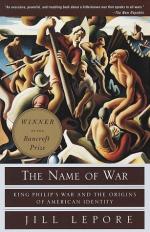
|
| Name: _________________________ | Period: ___________________ |
This test consists of 15 multiple choice questions and 5 short answer questions.
Multiple Choice Questions
1. Passaconaway was a powerful medicine man and sachem of what tribe?
(a) The Cherokee tribe.
(b) The Penacook tribe.
(c) The Mohawk tribe.
(d) The Mohegan tribe.
2. When was Metacomet born?
(a) 1648.
(b) 1675.
(c) 1639.
(d) 1676.
3. In the Prologue, the author describes King Philip's War as being almost over in what year?
(a) 1676.
(b) 1675.
(c) 1616.
(d) 1648.
4. When was Hugo Grotius born?
(a) 1677.
(b) 1548.
(c) 1583.
(d) 1489.
5. When was the book A Relation of the Troubles which Have Hapned in New-England by Reason of the Indians There from the Year 1614 to the Year 1675 published?
(a) 1677.
(b) 1612.
(c) 1642.
(d) 1676.
6. One house, known as what, was burnt in King Philip's War but was rebuilt shortly thereafter near downtown Medfield, Massachusetts?
(a) The Orchard House.
(b) The Peak House.
(c) The Medfield Mansion.
(d) The Boston House.
7. Increase Mather was a Puritan minister who was involved with the administration of what college?
(a) Princeton University.
(b) Boston College.
(c) Harvard College.
(d) Yale University.
8. John Eliot's efforts as a missionary earned him what nickname?
(a) "The White apostle".
(b) "Saint Eliot".
(c) "The Indian apostle".
(d) "The Christian apostle".
9. What were the villages of Christian Indians called?
(a) White towns.
(b) Bible towns.
(c) Red towns.
(d) Praying towns.
10. Who served as governor of Plymouth Colony from 1673 to 1680?
(a) Richard Callicot.
(b) Josiah Winslow.
(c) John Alderman.
(d) William Hubbard.
11. When did the Pequot War begin?
(a) 1615.
(b) 1654.
(c) 1662.
(d) 1634.
12. The colonists lost about how many men in the Great Swamp Fight?
(a) 70.
(b) 59.
(c) 25.
(d) 67.
13. When was A Brief History of the War with the Indians in New-England published?
(a) 1612.
(b) 1676.
(c) 1677.
(d) 1642.
14. What has been described as a law whose content is set by nature and is thus universal?
(a) Earth Law.
(b) Human Law.
(c) Natural Law.
(d) The Law of Gravity.
15. What does the author say represented filth and chaos to the Puritans in Chapter 4, Where is Your O God?
(a) Drinking alcohol.
(b) Eating pork.
(c) Eating chicken.
(d) The letting of blood.
Short Answer Questions
1. What was a Native American tribe formerly inhabiting western Massachusetts, especially around the confluence of the Deerfield and Connecticut Rivers in Franklin County?
2. Where was William Hubbard born?
3. A prodigious learner, Hugo Grotius entered the University of Leiden when he was how old?
4. According to the author in Chapter 4, Where is Your O God?, due to their great losses, many New England colonists thought God was punishing them for their failure to do what?
5. Who was the first Englishman to learn the Algonquian language?
|
This section contains 402 words (approx. 2 pages at 300 words per page) |

|




